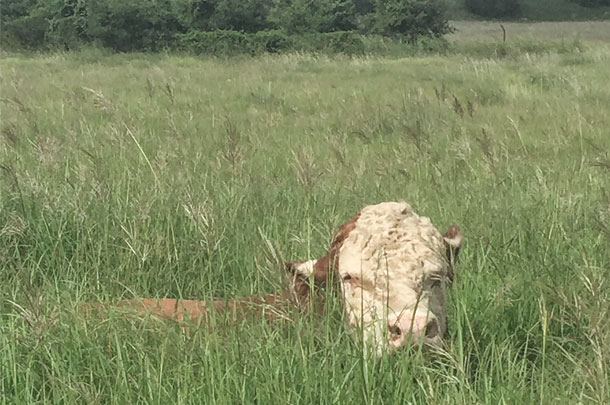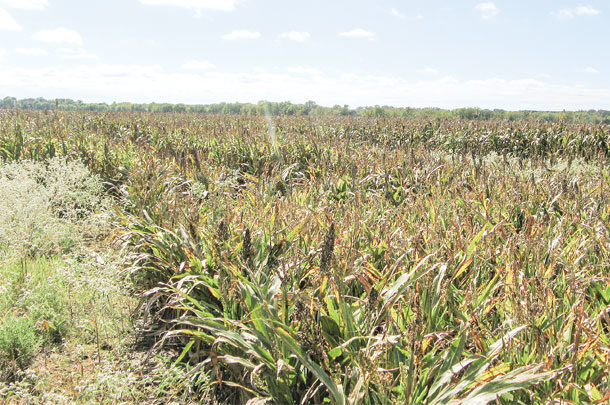Failure to control the feed bill can erode ranch profits very quickly, even to the point of bankruptcy. The most economical feed is normally forage standing in the pasture. Recognizing this fact, many successful producers have adopted various types of 365-day grazing systems that significantly reduced their annual feed costs. Two examples in Texas are Legends Cattle Company and 7R Ranch.
Legends Cattle Company
The primary focus of the Legends Cattle Company near Emory (east of Dallas) is producing good-quality seedstock affordable to commercial cow-calf producers. The Legends management team realized that, to meet this goal, significant decreases in input costs would have to occur. Every facet of the operation was thoroughly scrutinized to identify areas where alteration in management practices could result in cost reduction. The number one objective evolving from the study was to reduce feed and hay costs.
“We determined the best way to accomplish this objective was to develop a 365-day grazing plan,” said Todd Garrett, owner of Legends Cattle Company. “A cost analysis showed a savings of 150 dollars per head could occur from increased utilization of pasture forage rather than continued hay and haylage production and purchasing local corn.”
“Like any good building project, we had to first lay the foundation,” Garrett said. “We changed from year-round breeding to a defined breeding season to make it possible to manage cattle in groups based on their nutrient requirements. Young, growing cattle are separated from mature cows, fall-calving cows from spring-calving cows and lactating cows from dry cows.”
The Legends team collects forage samples for nutrient analysis with primary emphasis on crude protein (CP) content and total digestible nutrients (TDN) – a measure of energy. These annual analyses are used to match cattle nutrient needs with forage nutrient content. The results are also valuable for identifying nutrient gaps and determining if supplementation is warranted. Soil is tested annually for all macro- and micronutrients, and the analyses are used to determine types and amounts of fertilizers needed to correct any nutrient deficits.
Guidelines in the Legends grazing plan allow for consideration of early weaning as an alternative to supplemental feeding and the use of fertilizer to increase forage protein content. They found that cost of nitrogen is normally much lower than supplemental feed, so fertilization is often a cost-reducing practice.
Pregnancy testing cows after breeding season provides an opportunity to cull open cows to avoid paying further maintenance expenses. Another part of the 365-day grazing foundation is weed control. Studies have shown the amount of forage production is normally three or four times greater with weed control than without. Research also shows that it generally doesn’t pay to fertilize pastures unless weeds are controlled prior to the application.
“We had to develop a rotational grazing system for our 365-day grazing plan for it to be effective. The primary reason for discontinuing continuous grazing was to allow time for pastures to rest,” said Garrett. “We use the old grazing rule of thumb by utilizing half of the forage and leaving half, which allows the pasture to recover from use more rapidly and ultimately grow more forage per acre.”
The grazing plan includes grazing stockpiled coastal bermudagrass during late fall and early winter. Sorghum is planted for January and February grazing while it is dormant. Grain intake is managed by limiting grazing periods.
Chisholm tall fescue, a cool-season perennial, was planted for January and February grazing as well. This fescue is a new endophyte-free, summer-dormant variety developed by Noble Research Institute and is commercially available from Warner Brothers Seed Company in Lawton, Oklahoma. The older varieties of tall fescue require at least 35 to 37 inches of annual precipitation to survive, whereas Chisholm is adapted to areas with 24 inches or greater annual rainfall.
TAMTBO annual ryegrass is used for early spring grazing. This variety generally reseeds itself during the winter and doesn’t require replanting every year. TAMTBO was developed by Texas A&M AgriLife Research and has a wide range of adaptability across the southern U.S. The plant is tall and has wide leaves, which enables it to supply a large amount of palatable forage. TAMTBO has good crown rust resistance. Growing coastal bermudagrass is grazed during late spring, summer and early fall.
7R Ranch
“I developed a 365-day grazing program because I wanted to kick the hay habit,” said Murray Randle, who owns and manages 7R Ranch. The ranch is a cow-calf operation near Granbury (south of Fort Worth). “It took me a few years, but I finally managed to remove hay from my feeding program. Cattle now harvest the grass, which saves me a lot of labor and expense. Cattle also recycle forage nutrients back into the soil.”

A Randle bull lies in old-world bluestem waiting for his next tour of duty. Photo by Murray Randle.
Randle uses a different grazing system than most ranches. Instead of grazing his native grasses during the growing season, he lets cattle graze them during winter. His native grasses include big bluestem, little bluestem, switchgrass, indiangrass and eastern gamagrass. Randle increases protein in the cattle’s diet by planting winter pastures with combinations of annual ryegrass and small grains. Randle rotates his cattle between the planted pastures and native forage. During the growing season, he moves his cattle through kleingrass, old-world bluestem, coastal bermuda and Tifton 85 pastures. Like Legends, 7R Ranch uses the old grazing rule of thumb by utilizing half of the forage and leaving half.
“My calving season is in the spring, so the cows are pregnant during winter,” Randle says. “To ensure they retain a body condition score of 5 to 6, I feed 7-and-a-half pounds of 20 percent protein cubes per animal per day. Herd performance tells me how well my nutrition and health programs are working. I have a 17-year-old cow that just gave me her 15th calf. A large part of her success is due to genetics, but good management was also required.”
Managers should remember that 365-day grazing requires multiple pastures to support an array of forage species for utilization during different months or seasons. Soil, climate or terrain may not be conducive to tillage and establishment of annual forage species on rangeland. Fortunately, however, rangeland in good condition has a diversity of native cool-season plants (grass and forbs) and browse for grazing after frost. Stockpiling forage is also an additional option, which extends the grazing period for warm-season forage. Good grazing management is necessary to maintain the rangeland plant diversity required for year-round grazing.










